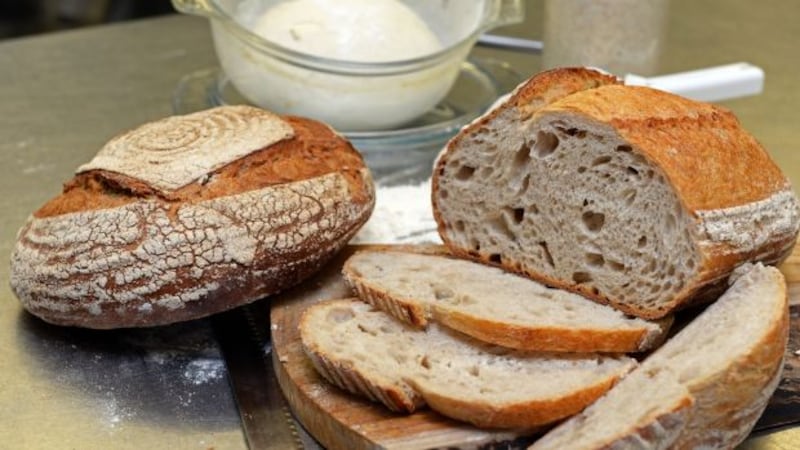It's Real Bread Week, and one of the best things we could do to improve the quality of our diet is to get into the habit of making bread, rather than relying on shop-bought, which is often of poor quality.
Patrick Ryan of Firehouse Bakery in Delgany and Firehouse Bread School on Heir Island in west Cork is a founding member of Real Bread Ireland. He has developed a recipe for a fuss-free sourdough loaf that needs very little kneading, proofs overnight in the fridge, and is ready to go straight into an oven the next morning to bake.
“I appreciate that for many, the biggest obstacle to baking bread at home is time. So to counter this, I have developed a recipe designed to fit around busy lives. Something that can be done by all and which requires no fancy equipment. So, no matter how crappy your oven is, everyone can bake great bread at home.”
Many bakeries will share sourdough starter with amateurs keen to begin baking bread. Real bread bakers have it tough enough, competing with the convenience and price advantage offered by supermarkets and corner stores, so isn’t it counterproductive, getting their customers to bake their own bread?
“Not at all. This is all about encouraging more people to bake real bread. I believe the more people that can enjoy real bread, the better. Over 70 per cent of the ‘bread’ consumed in this country, and I use the word very loosely, is mass-produced pre-sliced white. By baking for yourself you understand and appreciate the process involved and once you get the taste for it, there is no going back. And let’s be honest, the majority of us will not bake every day, so on the days that you don’t bake, you have us,” Ryan says.
But if you want to make your own sourdough starter from scratch, Ryan's instructions are below.
How to make and maintain sourdough starter
Day 1 50g wholemeal flour, 50g water
Place the flour and water into a clean bowl and stir together until fully combined. Cover and leave at room temperature overnight.
Day 2 75g wholemeal flour, 75g water
To the sourdough starter add 75g wholemeal flour and 75g water. Stir together until fully combined. Cover and leave at room temperature overnight.
Day 3 100g water, 100g wholemeal flour
Discard 100g of sourdough starter. To the remainder, add the flour and mix in the water. Cover and leave overnight.
Day 4 100g water 100g, wholemeal flour
Discard 150g of sourdough starter and to the remainder add the flour and water. Cover and leave overnight. The starter should start to smell pleastantly sour with small bubbles appearing on the surface.
Day 5 150g water 150g, strong white flour
Discard 200g of sourdough starter. Add the flour to the remainder of the starter, and mix in the water. Cover and leave overnight. The starter should appear active and full of bubbles.
Day 6 200g water 200g, strong white flour
The starter should be quite active now and be full of little bubbles and smell slightly sour. Discard 250g of sourdough starter. Add the flour and mix in the water. Cover and leave overnight.
Day 7 The starter should now be very active and full of bubbles and is now ready to use.
Maintaining your starter
To refresh or feed the sourdough starter, whatever weight of starter you have, add the same weight of flour and the same weight of water. Stir everything together. If the sourdough starter is stored at room temperature it will require to be refreshed/fed every day. For the home baker who you might only bake once a week having to feed/refresh your sourdough starter every day can become quite expensive. Therefore, your starter can be stored in the fridge for up to 10 days and taken out when needed.
“The only reason we discard some of the starter is to prevent you from ending up with too much,” Ryan says. “The more starter you have, the more you have to feed. For a home baker you only require a small amount.”

Patrick Ryan's easy overnight sourdough
Ingredients
500g strong white flour
5g salt
325g water
150g sourdough starter
Method
1. Add the flour to a clean mixing bowl. Mix the salt through the flour. Add the water and sourdough starter. Combine all the ingredients to form a rough dough.
2. Turn the dough out on to a clean work surface. Knead the dough for 10 seconds. Return the dough to the mixing bowl and leave to one side for approximately 10 minutes. When kneading, do not worry if the dough is slightly wet or sticky. Resist the temptation to add any extra flour.
3. After 10 minutes, turn the dough out onto the work surface and knead for another 10 seconds, then return the dough to the mixing bowl and allow the dough to rest for a further 10 minutes. The dough will need to be kneaded one more time. After the third time of kneading for 10 seconds, the dough should be smooth, smooth and elastic.
4. Return the dough to the mixing bowl, cover with cling film and allow it to prove for four hours at room temperature. After four hours, turn the dough onto a work surface and knock it back. Knocking back simply involves knocking the air from the dough and equalising the temperature within the dough. Form the dough into a tight round ball.
5. Line a 2.5l round Pyrex dish with a clean tea towel and dust with flour. Place the dough, seam side facing up, into the dish. Cover the dish with the lid, put it in the fridge and leave it overnight.
6. Using a fridge reduces the temperature of the dough, allowing it to prove slower and longer, which allows for greater development of flavour within the dough and increases its digestibility. As dough ferments or proves, the gluten within the dough breaks down. The longer a dough is allowed to prove, the more flavour it will have and the easier it is to digest.
7. The next morning, preheat your oven to 230 degrees Celsius/gas 8. Remove the Pyrex dish containing the dough from the fridge. Flip the Pyrex dish over, so the bowl of the Pyrex dish now becomes the lid. Remove the tea towel.
8. Using a sharp knife, cut the surface of the dough; this is what is known as the baker's signature. The dough can be cut up to half a centimetre deep. Put the lid back on and place the dish in the preheated oven. Baking the dough with the lid on creates steam, which will allow the dough to rise and open up while baking. The dough will need to be baked for 50 minutes. After 25 minutes, remove the lid from the dish and continue to bake for a further 25 minutes.
9. Once baked, remove the bread from the dish and allow it to cool.











